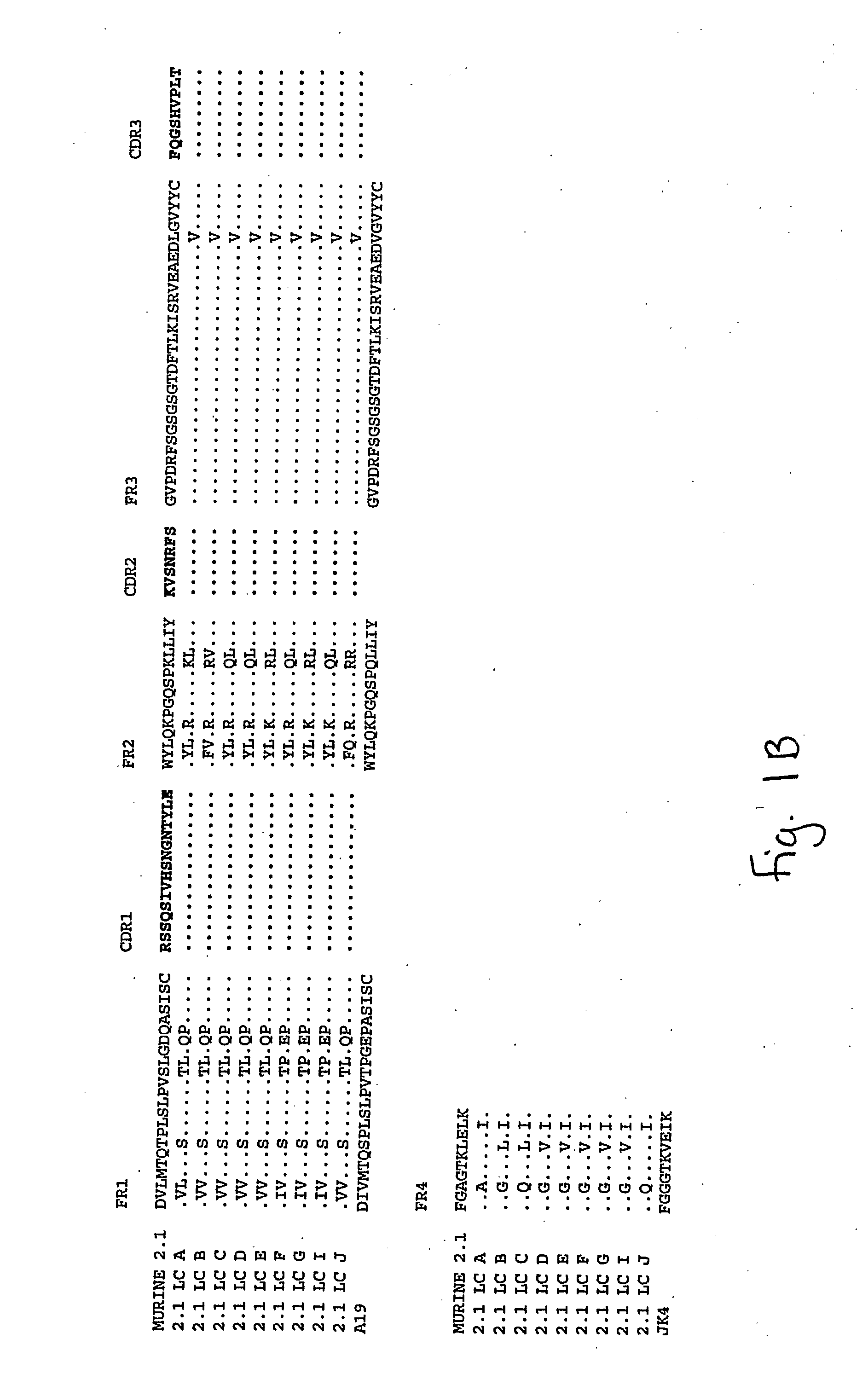Humanized Anti-Amyloid Antibody
a technology of amyloid and antibody, applied in the field of amyloidogenic disorders and compositions, can solve the problems of high nursing home costs for society, high burden on family caregivers, and high risk of health care crisis
- Summary
- Abstract
- Description
- Claims
- Application Information
AI Technical Summary
Benefits of technology
Problems solved by technology
Method used
Image
Examples
example 1
Production and Purification of Humanized Anti-Amyloid Antibody
[0196]The monoclonal anti-amyloid antibody 2.1 is a murine IgG1 produced from a hybridoma cell line.
[0197]Total RNA was isolated from the murine hybridoma 2.1 expressing an anti-human Amyloid binding monoclonal antibody and purified. A 5′ RACE (rapid amplification of cDNA ends) oligo was added to the RNA. First strand cDNA was synthesized from this modified RNA using a random primer with an extension adapter. A set of 5′ RACE PCRs (polymerase chain reactions) was performed to amplify the cDNAs that coded for the anti-human Amyloid antibody. For the complete light chain, a RACE PCR was preformed using a nested 5′ RACE primer as the forward primer and a murine kappa constant region primer as the reverse primer. The RACE PCR for the variable region of the heavy chains used a nested 5′ RACE primer as the forward primer and the reverse primer was a rat / mouse IgG1 specific constant region primer. RACE products were cloned and t...
example 2
In Vitro Binding of Antibodies
[0201]This example evaluates the in vitro binding of (“2.1 A”), 2.1 chimera and a variety of humanized 2.1 antibodies to Aβ (monomer and fibrils) and to collagen fibrils. All candidates are run at multiple concentrations in order to obtain concentration response information (where response=binding). From the concentration response curve one can determine an EC50 (the concentration that provokes a response halfway between baseline and maximum response). The EC50 is reflective of binding affinity; however, under the conditions used here, it is not a direct measure of KD. As a negative control, collagen fibrils were used to assess non-specific binding of antibodies.
[0202]The fibrils (Aβ or collagen) were diluted to 10 μg / ml in water and mixed thoroughly. The solution was aliquoted into the wells of a microtiter plate (Immulon-2; VWR; Cat # 62404-972) at 50 μl per well (resulting in 0.5 μg fibrils / well final). The plate was dried overnight by being placed u...
example 3
Kinetic Analysis of mAb 2.1 Binding to Human Aβ-Peptides
[0208]Kinetic binding analysis was performed using BIAcore to study the interaction of mAb 2.1 and various humanized 2.1 antibodies to human Aβ40 and Aβ42 aggregates and monomers.
[0209]Preparation of BIacore Chip Surfaces: Immobilization of Proteins to a Biacore sensor chip (CM5) was performed according to manufacturer's instructions. Briefly, carboxyl groups on the sensor chip surfaces were activated by injecting 60 μL of a mixture containing 0.2 M N-ethyl-N′-(dimethylaminopropyl)carbodiimide (EDC) and 0.05 M N-hydroxysuccinimide (NHS). Specific surfaces were obtained by injecting rProtein G (Pierce), goat anti-mouse Fc (Jackson Immuno Research Lab) or Aβ aggregates diluted in 10 mM acetate, pH 4.0 at concentrations between 5 and 20 μg / mL. Excess reactive groups on the surfaces were deactivated by injecting 60 μL of 1 M ethanolamine. Final immobilized levels were about 10000 resonance units (RU) for the Protein G and anti-mous...
PUM
| Property | Measurement | Unit |
|---|---|---|
| concentrations | aaaaa | aaaaa |
| concentrations | aaaaa | aaaaa |
| concentrations | aaaaa | aaaaa |
Abstract
Description
Claims
Application Information
 Login to View More
Login to View More - R&D
- Intellectual Property
- Life Sciences
- Materials
- Tech Scout
- Unparalleled Data Quality
- Higher Quality Content
- 60% Fewer Hallucinations
Browse by: Latest US Patents, China's latest patents, Technical Efficacy Thesaurus, Application Domain, Technology Topic, Popular Technical Reports.
© 2025 PatSnap. All rights reserved.Legal|Privacy policy|Modern Slavery Act Transparency Statement|Sitemap|About US| Contact US: help@patsnap.com



